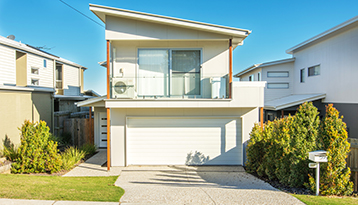Ian Ugarte. 26/07/2018
In Australia, there are significant housing and affordability issues. In reality, it’s actually a size issue: we have the largest houses in the world, but with an average household size of only 2.5 people. The parents are in one room and a child in the other. This is the typical four-bedroom, two-bathroom house.
With 12 million empty bedrooms, the types of houses we build in Australia do not make sense – we are building the wrong product.
The answer here is not to build more housing, it's actually to retrofit – or, if you are building, ensure you build houses with individual micro-apartments that suit the needs of the modern population.
There are policies across the country to take low-density residential houses and divide them into small micro apartments. As the landlord, you get double-digit returns and the potential to double your income, with opportunities for tenants to benefit from them as well.

To understand the significance of affordability, we need to consider the federal definition, which is not spending more than 30% of your pre-tax wage on rental accommodation or mortgage. If you're spending more than that, not including utilities or food or any other costs, you are considered to be living under housing stress. In some metropolitan areas of Australia, 96% of people who are renting are living under housing stress.
Looking at this another way, as an example in one capital city, the median rent for a four-bedroom house is $420, but for a two-bedroom house it’s $415.
As an investor, you would rightly ask why you’d build a four-bedroom house when it's not giving you a significantly stronger return.
This particular four-bedroom house rents for $420. Now, if I use the policies that are available around the country and create small self-contained areas that share one common area, we can get a much better return for our money. Rent can be offered to tenants for $200 to $250 each apartment. The return does act as a ratio. This means that, in this household, I am able to get a rental return of $800-$1,000-plus per week, as opposed to only $420.
.jpg) What we are talking about is making sure that you use policies in the rooming house, boarding house and communal residence with communal living areas. Remember, though, that the fines for doing things illegally are huge, including jail time, which is why you need to know these rules and regulations, put them in place, and use the incentives appropriately.
What we are talking about is making sure that you use policies in the rooming house, boarding house and communal residence with communal living areas. Remember, though, that the fines for doing things illegally are huge, including jail time, which is why you need to know these rules and regulations, put them in place, and use the incentives appropriately.
The people living in these types of properties are getting a much cheaper rent. Rather than paying $420, they're virtually halving their rent, paying $200-250. They have the bonus of only having a small portion of the property to look after, and with their utilities included, they are saving even more. All of this gives them the opportunity to put money aside for investing in some property themselves.
And no, they are not drug dealers, criminals and low socio-economic people who will have difficulty paying the rent. Around 80% of renters want smaller houses, and 80% of housing is too big. Can you see that we've got an upside-down marketplace that hasn't been catered for, for many years?
What we’d suggest is, if you’re a mum and dad investor with somewhere from one to six investment properties, it might be time to approach your investment journey differently. By doing this, you're going to be targeting a marketplace that really needs accommodation, whilst also enjoying maximum returns – the ultimate win-win.
It’s no longer sustainable for the government to put money towards housing. In effect, you are filling a huge gap and taking pressure off the bottom of the market through providing this style of accommodation.
When you build or retrofit the right product, you will get a better return.
NO ONE LOSES IN THIS SCENARIO!
I believe, without a doubt, that the opportunity is there to be able to create income out of residential property, at 10%, 12%, 14% and 16% returns. We generally talk about half the house, double the income or quarter house, double the income. People are wanting to live simpler and live smaller to save money and put themselves in a better financial position, and this model is the ideal solution.
It needs to make SENSE before it makes dollars. Every property that you offer is not only going to put you in a better position, but it's also going to affect a resident in a positive way so they can save some money. They can go off and invest as well, and you can continue to do the same thing.
We have! What we do is create genuine community connection by providing elegant housing solutions, which foster housing diversification for everyone in the community.
Disclaimer: while due care is taken, the viewpoints expressed by contributors do not necessarily reflect the opinions of Your Investment Property.

